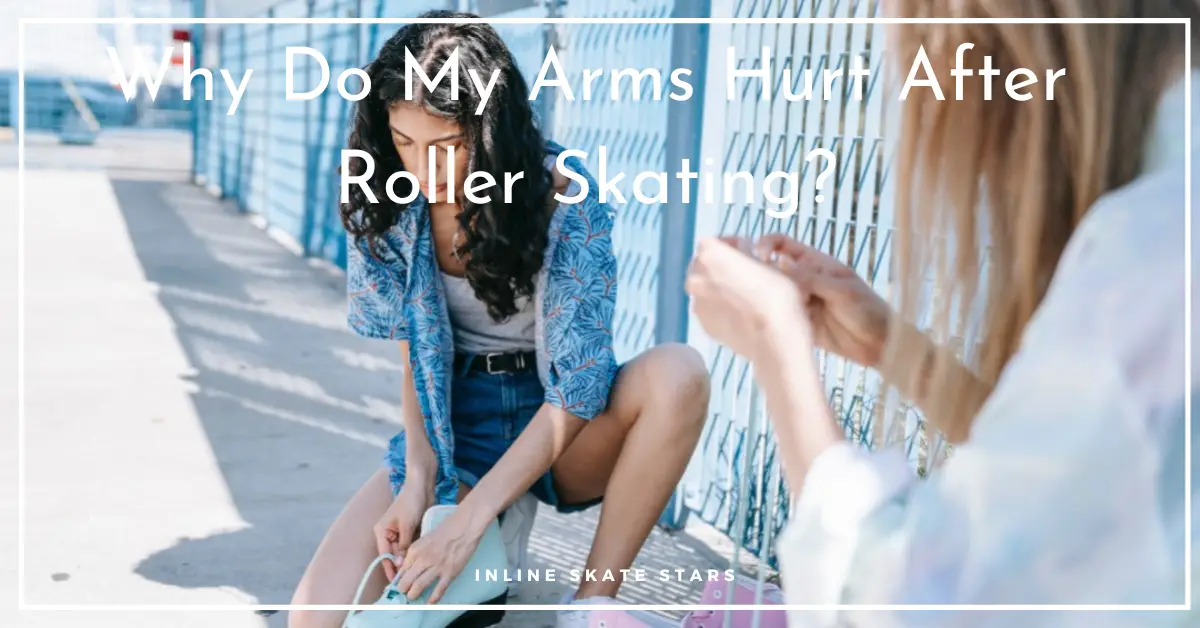Why do my arms hurt after roller skating?
Roller skating is a fun sport and leisure activity. It’s a low-impact aerobic activity that improves heart health, burns calories, and strengthens muscles.
But, as with everything in life, you can experience drawbacks. One of the challenges you may face is your arms hurting after skating.
But this should not discourage you. In most cases, the pain will go away in about three days. Read on to learn why your arms hurt after roller skating and what you can do to ease the pain.
Why Do My Arms Hurt After Roller Skating?
Why do my arms hurt after roller skating? Your arms hurt after roller skating because of muscle sprains, joint dislocations, arm muscle inflammation, bone fractures caused by falls, or muscle strain from over-skating.
Why Your Arm Hurts After Roller Skating
Your arms may hurt after roller skating for many reasons. Below, we dive deep into primary the reasons!
1. Arm Injury From Falls
Falling is innate in skating. And you should expect to fall a couple of times as a newbie. Unfortunately, sometimes when you fall, you sustain an injury.
Skating arm injuries include muscle sprains, joint dislocations, and bone fractures.
When we fall, we instinctively extend our arms to brace the fall and avoid falling on our faces. It’s, therefore, no surprise that the arms are the most vulnerable to skating injuries.
Arm pain from fall injuries is immediate and justifiable. You could fall due to poor balance, inability to break, and distraction from obstacles.
2. Delayed Muscle Onset Soreness (DOMS)
However, other times you finish a skating session unscratched. Not a single fall. Not even close. You feel terrific. You give yourself a high-five. And pat yourself on the back.
To your dismay, you wake to sore arm muscles the following morning. Muscle hangover? Is that even a thing? You’re not jinxed. You’re experiencing DOMS.
DOMS – delayed onset muscle soreness – sets off after at least 12–24 hours following heavy skating.
The arms are vital for balance and propulsion when skating. Skaters swing their arms to maintain fluid balance when gliding.
Your arm muscles have a comfort zone determined by your level of activity. When you overskate, you can break this threshold.
Overskating can result from gliding too aggressively or skating for an extended duration. Or both. Over skating causes muscle strain and micro-tearing leading to muscle inflammation and soreness.
3. Muscle Strain
Overusing the arms during skating can cause micro tears in the arm muscles. The micro-tears will cause discomfort and inflammation of the arms. The pain often sets in the following day.
Strain pain will start fading after three days and eventually disappear on its own. Also, light relaxation exercises like stretches, massage, and yoga enhance blood circulation and muscle nutrition. These exercises enhance the recovery process.
4. Ligament Sprain
Sometimes you may twist your arm ligaments when skating. It may be the shoulder, elbow, or wrist joint. The pain will be concentrated on the joint whose ligaments are twisted.
A simple sprain will heal by itself. Take a rest to avoid aggravating the situation.
5. Joint Dislocation
When you fall on your arms, your shoulder, elbow, wrist, or finger joint may knock out alignment. Joint dislocation causes sharp pain in the affected joint.
A dislocated arm joint may trap a blood vessel or nerve and cause complications, so be sure to see a doctor immediately.
6. Bone Fracture
Though rare, you may suffer a bone crack or, worse, a broken arm causing severe acute pain if you fall at high speed. Seek medical attention immediately.
How to Avoid Arm Pain after Roller Skating
Thus we have examined why your arms hurt after roller skating. Let’s now look at ways to reduce the risk of skating arm injuries.
Learn Balance
As we’ve seen, arm pain sometimes results from fall injuries. Learning to balance on skates will help you reduce the number of falls you endure.
Skating posture is central to skating balance. A good posture balances your body weight on the balls of your feet. To achieve a perfect skating posture:
- Maintain your head up and gaze forward.
- Place your skates shoulder-width apart.
- Squat by slightly bending your knees.
Another critical aspect of balance is fitting comfortable roller skates. Ensure your skates are the correct size. Oversize or too tight skates are uncomfortable and distractive.
Learning to Fall Correctly
It matters how you land because falling you will.
First, squat to reduce the distance of fall. Then bend forward, and land on both your arms and knees simultaneously.
Use fists to avoid breaking your fingers. Also, bend your elbows to increase the time of impact. Falling like this reduces the strain on the arms.
Now that’s a mouthful. It would help if you practiced it till it becomes second nature.
Practice falling? Yes. Practice falling on a soft, smooth surface while skating at low speed. Remember to wear elbow pads and wrist guards.
After falling, get to an “on your mark” position. To achieve this position, place your feet shoulder-width apart, kneel on one knee, and extend the other leg in front of you. Ground the arms on either side of the body.
Then use all your fours to lift yourself off the ground in this position. Using all fours reduces the strain on the arms.
Regular Exercise
You can help ease arm pain resulting from DOMS through regular exercises. Regular workouts build muscle flexibility and endurance. Your skating comfort zone increases as the muscles grow to meet the raised demand.
A healthy, well-balanced diet is crucial for muscle development. While proteins promote muscle growth and repair, carbohydrates supply energy for the muscles to perform activities.
Warm-up Before Roller Skating
Warming up before getting into the skates relaxes your muscles and prepares them for a smooth skating experience.
Additionally, warming up increases your flexibility and range of motion and reduces your risk of injury.
How to Manage Roller Skating Arm Pain
Minor arm injuries from roller skating will heal on their own given time. However, I recommend you try RICE – rest, ice, compression, and elevation.
RICE advocates resting to assess the damage while applying ice to relieve the pain. At the same time, wrap and raise the injured part to reduce blood pressure and inflammation.
You can also use over-the-counter painkillers to ease the pain. A healthy diet is also critical for muscle repair.
If you incur a severe injury, please see a doctor. If in doubt whether it’s serious, see a doctor – rather be safe than sorry.
Why Do My Arms Hurt After Roller Skating? | Wrapping Up
After roller skating, your arms can hurt because of micro rips and inflammation from skating activity. Falls can also cause muscle strains, joint dislocations, and bone fractures, which can cause pain.
Learning to balance on skates, falling correctly, doing regular exercises, and warming up before skating can help prevent or at least ease the pain.
Fortunately, the pain will go away on its own with time. You can also shorten the recovery period by eating healthy, caring for the injured area through RICE, and soothing the muscles.
Over-the-counter painkillers can also come in handy to ease the pain.



